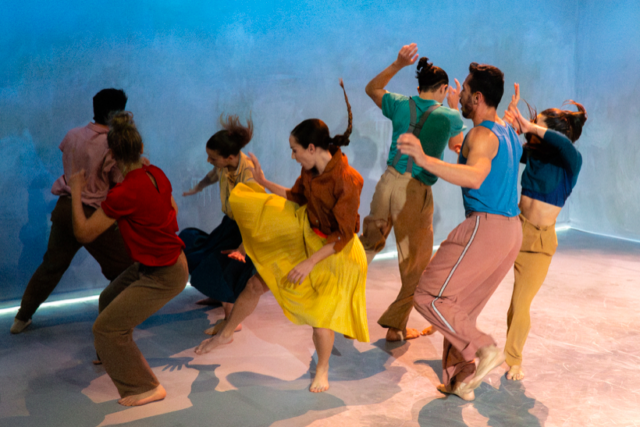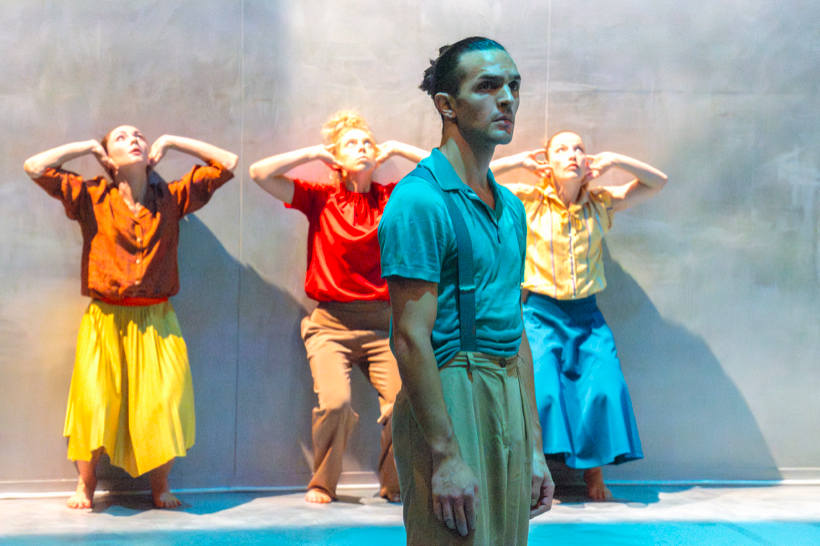
For the English version, please, scroll down
BERLINO – Il 4 ottobre 2023, a Berlino, ha debuttato les égarés nuova produzione della cia. toula limnaios. Nell’Halle Tanzbühne, storica sede della compagnia, il pubblico viene disposto su due lati che delimitano lo spazio performativo, lasciando le altre due pareti fungere da setting della performance. Anche le luci, curate da Domenik Engemann e Felix Grimm, creano un’atmosfera differente dal solito, più cinematografica che da teatro tradizionale. Come sempre, l’azione performativa inizia mentre la gente prende posto. I danzatori, infatti, sono già tutti seduti lungo le pareti mentre Daniel Afonso, con fare furtivo, si avvicina prima a uno e poi a un’altro dei suoi colleghi, frugando nelle loro tasche, in cerca di qualcosa. Del resto, come il titolo lascia intendere, i protagonisti di questa storia sono coloro che vivono ai margini, coloro che, per qualche ragione, hanno perso la ‘retta’ via.
A questo punto Laura Beschi inizia a ridere, forse perché ubriaca o forse perché assorta in un suo mondo, e a cadere, mentre qualcuno la soccorre e la sposta di peso ogni volta in un punto diverso della sala. Poi tutti corrono fermandosi improvvisamente in pose statuarie per ritrovarsi al centro, l’uno sull’altro, come addormentati o privi di coscienza. Alessio Scandale è sveglio e disfa questa montagna umana. Molto bella, quasi un omaggio al teatro danza di Pina Bausch, la parte in cui si ritrovano tutti sulla parete eseguendo la stessa sequenza di movimenti, mentre Hironori Sugata sposta un divano, unico oggetto di scena.
Da questo momento si ripetono passaggi in cui qualcuno si siede sul divano per poi esserne disarcionato. Interessante anche la disposizione dei performer in scena, particolarmente suggestiva è l’immagine che vede Francesca Bedin, insieme a Karolina Kardasz e Amandine Lamouroux (nuovi membri della compagnia) eseguire una sequenza attaccate a una parete, mentre gli altri occupano il centro del palco, per poi venire in ‘proscenio’ mentre gli uomini sostengono e spostano Laura Beschi.
Quando il gruppo si ritrova al centro, tutti iniziano a camminare avanti e indietro attraverso scatti della testa e delle spalle che ne provocano lo spostamento. Bello il duetto di Leonardo D’Aquino e Francesca Bedin mentre gli altri ‘dormono’. Seguono sequenze sul pavimento, duetti e camminate (le donne con il mento sulle spalle dei compagni) che intrattengono il pubblico fino alla fine.
Ancora una volta Toula Limnaios sorprende con una creazione diversa dalle precedenti. Particolarmente bella e appassionante soprattutto la prima parte de les égarés, in cui la storia prende forma lentamente, attraverso immagini e sequenze differenti che si svolgono simultaneamente sul palco. Nonostante lo stile della Limnaios sia riconoscibile, qui la coreografa si cimenta in un interessante e nuovo uso dello spazio, sia relativamente alla disposizione dei danzatori in scena che del pubblico in sala. Ognuno, infatti, oltre a scegliere quale azione performativa seguire, ha una visuale e una prospettiva dell’insieme diversa dagli altri, motivo per cui lo spettacolo andrebbe visto più volte.
A parte gli aspetti ‘tecnici’ les égarés è una storia attuale, che dimostra ancora una volta la sensibilità e l’occhio della coreografa greca nel cogliere e nel raccontare la realtà.

BERLIN – On October 4th, 2023, les égarés, a new cia. toula limnaios production, debuted in Berlin.
At the Halle Tanzbühne, the company’s historic headquarters, the audience is placed on two sides that delimit the scene, leaving the other two walls as setting for the performance. Even the lights, designed by Domenik Engemann and Felix Grimm, create a different atmosphere than usual, more cinematic than traditional theatre.
As always, the performative action begins while the audience take their seats. The dancers, in fact, are already ‘collapsed’ along the walls while Daniel Afonso, furtively, approaches one and then the other ones of his colleagues, poking in their pockets, looking for something. After all, as the title suggests, the protagonists of this story are those who live on the margins, those who, for some reason, have lost their path. At this point Laura Beschi begins to laugh, perhaps because she is drunk or perhaps because she is absorbed in her own world, and to fall, while someone helps her and physically moves her to different points in the room each time.
Then everyone runs, suddenly stopping in statuary poses to find themselves in the center, one on top of the other, as if asleep or unconscious.
Alessio Scandale is awake and undoes this human mountain. Very beautiful, almost a tribute to the dance theater of Pina Bausch, the part in which they all find themselves on the wall performing the same sequence of movements, while Hironori Sugata moves a sofa, the only scenographic object. From this moment on, passages are repeated in which someone sits on the sofa only to be dislodged. The position of the performers on stage is also interesting, particularly evocative is the image that sees Francesca Bedin, together with Karolina Kardasz and Amandine Lamouroux (new members of the company) performing a sequence attached to a wall, while the others occupy the center of the stage, and then come to the ‘proscenium’ while the men support and move Laura Beschi.
When the group gathers in the center, everyone begins to walk back and forth with jerks of the head and shoulders that started their movements. The duet of Leonardo D’Aquino and Francesca Bedin, while the others ‘sleep’, is beautiful. This is followed by sequences on the floor, duets and walks (the women with their chins on their companions’ shoulders) which entertain the audience until the end.
Once again Toula Limnaios surprises with a creation different from the previous ones. The first part of les égarés is particularly beautiful and exciting. The story starts slowly, through different images and sequences that take place simultaneously on stage. Although Limnaios’ style is recognisable, here the choreographer tries her hand at an interesting and new use of space, both in relation to the arrangement of the dancers on stage and the audience in the Halle. In fact, everyone, in addition of choosing which performative action to follow, has a different view and perspective of the whole, which is why the show should be seen several times.
Aside from the ‘technical’ aspects, les égarés is a current story, which once again demonstrates the sensitivity and eye of the Greek choreographer in capturing and telling reality.














































